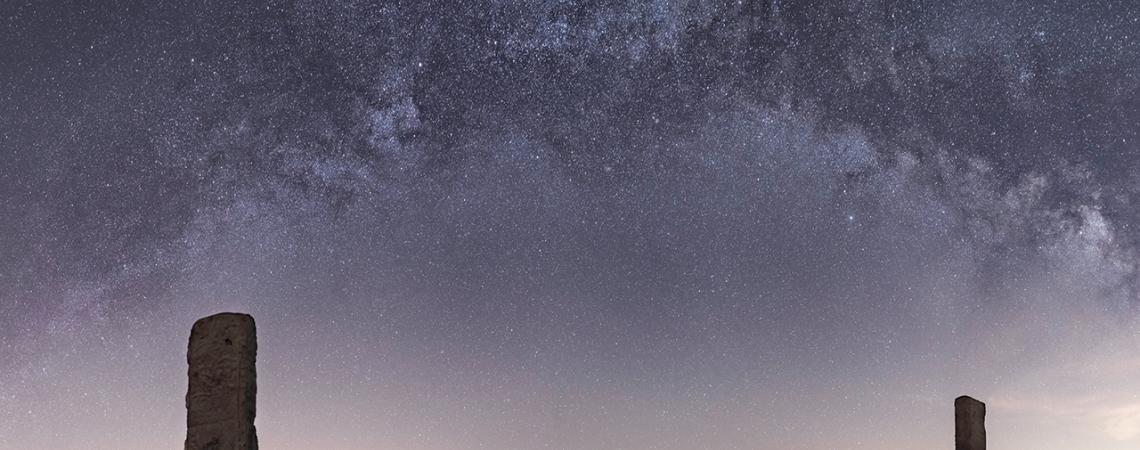The sky above Observatory Park is often dark enough to catch a spectacular view of the Milky Way, and the park is a favorite spot for amateur and professional photographers alike. (Photo by P. Sisto Images)
When Geauga Park District Naturalist Chris Mentrek is stargazing at Observatory Park, one of his favorite sights is the Summer Triangle. “The Milky Way stripe goes right through the triangle,” says Mentrek, “and Altair, Deneb, and Vega form its corners. They’re three of the brightest stars and are also points in the constellations Aquila, Cygnus, and Lyra.”
The beauty of Observatory Park is that people get to behold the wonders of the night sky without interference from artificial light. “City folks who come here are always amazed that they can see the Andromeda Galaxy or Milky Way with just their eyes because it’s a dark sky park,” says Mentrek. To detect celestial objects that are invisible to the naked eye, visitors also can access the 25.5-inch mirror reflecting telescope in the park’s Oberle Observatory. A good example is Albireo, a star in the head of Cygnus (the swan) that appears to be a single pale white dot. But it’s really two stars that are blue-green and orange in color. “You can’t tell it’s a double star until you see Albireo through a telescope, so it’s always fun to look at,” says Mentrek.
Opened in 2012, Observatory Park was developed to preserve the headwaters of the Cuyahoga River and to establish a dark sky park that protects a clear view of the nighttime sky by restricting light pollution. It’s located on 1,100 acres in the Geauga County countryside that Mentrek describes as “one of the darkest spots on dry land in northern Ohio.”
The site is more than 30 miles east of downtown Cleveland, and with an elevation of 1,254 feet, it’s far removed from the sky glow that characterizes urban areas. “The farther away from city lights a place is,” explains Mentrek, “the darker the sky gets.” In support of Observatory Park, nearby residents that include Amish families are also conscientious about minimizing artificial lights. “It certainly helps a dark sky park when the neighbors don’t use electricity at night,” says Mentrek.
The Arizona-based International Dark-Sky Association (IDA), whose mission is conserving night skies, certifies dark sky places throughout the world and employs an Olympics-style system to evaluate the quality of their nocturnal skies. To date, IDA has recognized less than 40 dark sky parks in the United States, and it has designated Observatory Park as a Silver-Tier International Dark Sky Park. “East of the Mississippi River, there are no gold-rated parks,” says Mentrek. “The only gold ones are out west in deserts or on the highest mountains.”
Besides the prestige of being the first IDA park in Ohio, Observatory Park is probably the state’s most astronomy-friendly public park. Not only does the Oberle Observatory give people the opportunity to eye the cosmos through its large Newtonian telescope, but the park’s Robert McCullough Science Center also has a planetarium where Mentrek presents astronomy shows. After informing visitors that a planetarium is the best way to look at the night sky while there’s still daylight, he likes to prove his point by showing them “the simplest planetarium anyone can have” — a black umbrella decorated with a map of the heavens.
The park also includes Case Western Reserve University’s old Nassau Astronomical Station and its 36-inch Cassegrain design telescope. Peter Mack, an expert at restoring and constructing telescopes, has spent much of the summer working on the research-grade telescope. When the Nassau Station’s renovation is completed later this month, Observatory Park will boast the largest telescope available to the public in Ohio.
“Observatory Park is a great astronomical destination because it fills the unique niche of providing people with powerful telescopes and a planetarium in a dark sky location,” says Mentrek. “It’s very rare to find all three in one place.”
Damaine Vonada is a freelance writer from Xenia.









